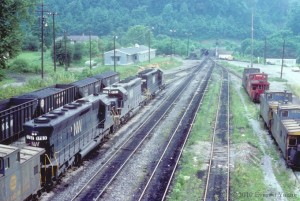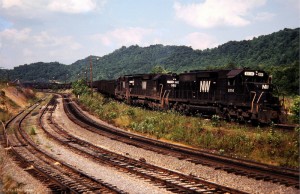by Harry J. Dolan (Retired NS Trainmaster)
 Big pusher consists (24 powered axles) were only used on loaded trains. “Time Freight” (General or Mixed Freight) pushers were limited to 14 powered axles. The former Southern pushed against cabooses, empty, and light loaded cars. As such, they limited pushers to 14 powered axles (example, two 4 axle & one 6 axle conventional units). High adhesion locomotive axles were counted as 1 1/3 conventional traction motors, hence, a C40-8 or an SD-60 with 6 actual axles would be counted as 8 axles. The N&W, on the other hand, pushed against 100 ton or heavier loads and limited their pusher consists to 24 powered axles (4 conventional SD’s or three 6 axle high adhesion units). Pushing against an empty or light car with more than 14 powered axles generated so much “in train” force that the empty or light car would simply be forced out of the train on curves. Prior to the “Caboose Off” agreement and repeal of VA Law requiring a caboose, N&W cut the pusher in ahead of the caboose and any empty cars (which were always listed on the consist as “NO PUSH”). Hence, say you had, 3 empty “Bad Order” hoppers and a M of W gon with rail in it for movement to Bluefield from Norton, and the only eastbound trains were coal trains. The 3 “Bad Order” empty hoppers and the gon would be placed just ahead of the caboose. On the Clinch Valley, eastbound trains needed a pusher from Finney to Tip Top. Prior to acquisition of the Clinch Valley Extension (INT), there were two pusher terminals on the Clinch Valley, Carbo and Richlands. Carbo pushers could work from Norton to Bluefield, and Richlands pushers could work from St. Paul to Bluefield and over “Dry Fork” to Auville, and up Richlands Branch toward Grundy. After we took over the former INT, I added a third Pusher terminal at Norton to handle coal trains up “Norton Hill” from Andover to Norton. Norton pushers could work from Andover to Carbo. The former Sou also had pushers assigned at Andover. They could work from Andover to Frisco and between Andover and St. Charles on the former Southern St. Charles Branch (originally part of Southern Bristol-St. Charles Mainline).
Big pusher consists (24 powered axles) were only used on loaded trains. “Time Freight” (General or Mixed Freight) pushers were limited to 14 powered axles. The former Southern pushed against cabooses, empty, and light loaded cars. As such, they limited pushers to 14 powered axles (example, two 4 axle & one 6 axle conventional units). High adhesion locomotive axles were counted as 1 1/3 conventional traction motors, hence, a C40-8 or an SD-60 with 6 actual axles would be counted as 8 axles. The N&W, on the other hand, pushed against 100 ton or heavier loads and limited their pusher consists to 24 powered axles (4 conventional SD’s or three 6 axle high adhesion units). Pushing against an empty or light car with more than 14 powered axles generated so much “in train” force that the empty or light car would simply be forced out of the train on curves. Prior to the “Caboose Off” agreement and repeal of VA Law requiring a caboose, N&W cut the pusher in ahead of the caboose and any empty cars (which were always listed on the consist as “NO PUSH”). Hence, say you had, 3 empty “Bad Order” hoppers and a M of W gon with rail in it for movement to Bluefield from Norton, and the only eastbound trains were coal trains. The 3 “Bad Order” empty hoppers and the gon would be placed just ahead of the caboose. On the Clinch Valley, eastbound trains needed a pusher from Finney to Tip Top. Prior to acquisition of the Clinch Valley Extension (INT), there were two pusher terminals on the Clinch Valley, Carbo and Richlands. Carbo pushers could work from Norton to Bluefield, and Richlands pushers could work from St. Paul to Bluefield and over “Dry Fork” to Auville, and up Richlands Branch toward Grundy. After we took over the former INT, I added a third Pusher terminal at Norton to handle coal trains up “Norton Hill” from Andover to Norton. Norton pushers could work from Andover to Carbo. The former Sou also had pushers assigned at Andover. They could work from Andover to Frisco and between Andover and St. Charles on the former Southern St. Charles Branch (originally part of Southern Bristol-St. Charles Mainline).
After we gained trackage rights over CSX (CRR) from St. Paul to Frisco (Kingsport, TN), there was no reason to move coal west of St. Paul toward Norton, hence no need for pushers on Bull Mountain (between St. Paul and Norton). CSX only had a slight grade up into Iron Mountain Tunnel. The balance of the line from St. Paul to Frisco was either level or down grade. In fact, southbound on the CRR between St. Paul and Frisco, a single GP7 was rated at 18,000 tons. On the other hand, should a “Southern” coal train be run from Kermit, WV to Scherer Steam Plant in Georgia via St. Paul-Norton (N&W), Norton-Appalachia (INT), Appalachia-Frisco (Sou), a big pusher would be required from St. Paul to the west end of Little Tom Tunnel (Carbo or Norton pusher) and a second pusher (Sou out of Andover) between Appalachia and “the 32 Mile Post” near Gates City, VA on the former Southern.
After we gained trackage rights over CSX, I only ran one loaded coal train via that route. On that occasion, I had two “Southern” coal trains (trains destined to locations on the former Southern) called and out of Carbo, VA. The first was stopped at Boody and the second at Carterton waiting for a CSX northbound to clear St. Paul. The CSX northbound derailed at Burton’s Ford, and CSX estimated it would be 8 hours before they could take our trains south. Carterton (passing track) would hold the second train, but the first train was too long for Boody (passing track-107 car lengths). Hence, the first train had the Clinch Valley Main line blocked. I had two options. One, double a portion of the first train over into Boody yard and take both crews off the trains and taxi them to Bulls Gap, TN which would ultimately result in at least two more crews being “deadheaded” back from Bulls Gap to Carbo; plus with Boody, Carterton, and Cleveland passing tracks blocks I effectively had a single track railroad on the Clinch Valley from Finney to Norton (about 40 miles). I elected a second option. Cut the 3 Hi-adhesion 6-axle units off the second train at Carterton, couple into the rear of the first train at Boody, and shove it over Bull Mountain to Norton. Since both crews were qualified over this route and within their working limits, I just left the second crew on the pusher units, dropped off “Norton Hill” into Appalachia and out onto the former Southern at Big Stone Gap at which point the engineer on the rear units opened the throttle again and shoved the train to the 32 mile post. At the 32 mile post, I cut the units off the rear, put the crew on the head end, and sent the train on to Bulls Gap, TN. I then put a former Southern “Pusher Crew” on the units, brought them back to Appalachia, put a Norton Pusher (N&W-Engineer only) on the units at Appalachia, pushed an eastbound coal train out of Appalachia to Norton, left the units on the rear, continued on to Carbo where the units went to the “Spark Track” (N&W for engine service track) to be called later when CSX cleared their derailment and could accept the train at Carterton. I don’t remember if the eastbound train got a Carbo pusher to continue on east or got one out of Richlands before it started up “Finney Hill”.
On another occasion when I had been at Norton about 3 weeks, Westmoreland Coal Company at Appalachia loaded a 100 car unit train destined for the Walnut Cove Steam Plant (S. Boston, VA). Under Southern management, the former Interstate had taken 8 to 10 hours to triple (make three trips) to get 100 car unit trains from Appalachia to Norton and interchange them to the N&W. Of course, this three trip maneuver and interchange necessitated an additional mechanical inspection and initial terminal air brake test at Norton. This was wasted time since an inspection and air brake test was conducted at Appalachian before leaving Westmoreland’s Transloader (Preparation Plant). Hence, I called the GST (General Superintendent of Transportation) in Atlanta and order 3 conventional 6-axle units. Atlanta (former Southern) had only 3 weeks earlier taken over dispatching locomotives from the former N&W System Operation Center (“SOC”). The “GST” (a former Southern officer), of course, asked me why I needed the units, and when I told him “a Pusher” he went ballistic, quoting the rule which limited pushers to 14 powered axles. I could have been nice and explained that on the Pocahontas Division we had special provisions for pushing with 24 powered axles, and that we only pushed against 100 ton, or more, loaded cars. However, I didn’t. I guess I was a little pissed at being told I couldn’t do something (on N&W, a Trainmaster “ran” his territory and what he said was law). Instead of explaining, I just told the GST, “I’d push with four six axles if I could get them together” and hung up. About 30 minutes later, now 2 AM, I got a call from my Superintendent (also a former N&W officer). The only thing he said was to ask me, “if I had to stir up all that $%&^ in Atlanta at 2 o’clock in the morning.” It seems the GST had called my Superintendent, at home, gotten him out of bed and demand that he take me “out of service” for saying “I would push with four 6-axle units if I could get them together.” I guess the only thing that saved my ass was when the GST jumped my superindendent, he just laughed and told the GST he probably had 6 or 8 four-unit, 6-axle pushers out working right now. Anyway, an empty train showed up, and I took the three 6-axle units off it to use as a pusher. As soon as the former Southern officers at Andover heard I was planning on putting three 6-axle units on the head end and three 6-axle units on the rear as a pusher and handle “The Walnut Cove Train” to Norton in one movement, they ordered the “Andover Wreck Train” (200 ton derrick). However, they canceled the Wreck Train and just stood there with their mouths open when, in 45 minutes, I had doubled a 100 car unit coal train together, made a brake test, pushed it up “Norton Hill”, and had it in and out of Norton headed for Bluefield. Of course, moves like using the units and crew off one coal train to push another (over Bull Mountain and out of Appalachia, on the former Southern) and using three, 6 axle units, to push up Norton Hill, and later using 24-axle pushers did nothing to dispel my reputation as a renegade.
Related Products:






This story is AWESOME! Leaves one wanting much more from the author.
Agreed.